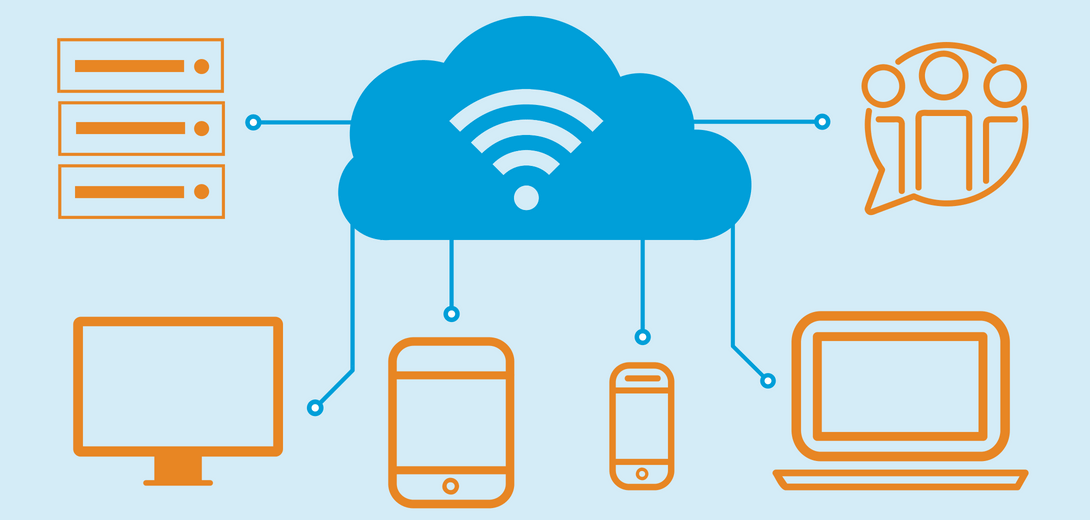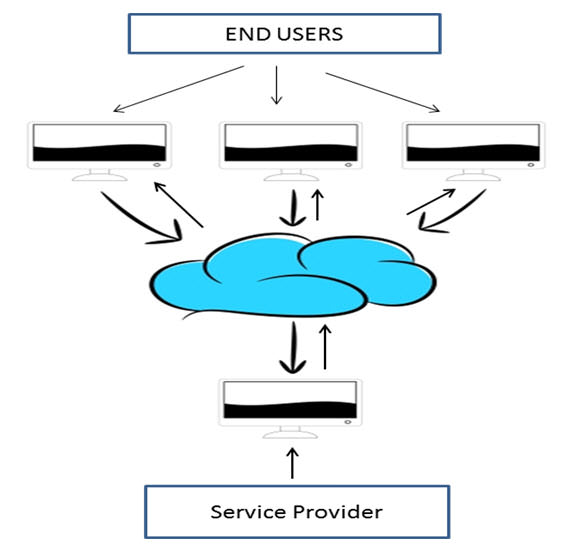
At the end of this lesson-
1. You will be able to explain the concept of cloud computing.
2. You will be able to describe the Deployment Models of cloud computing.
3. You will be able to describe the Service Models of cloud computing.
4. You will be able to explain the advantages and disadvantages of cloud computing.
Go for Bangla Version
What is Cloud computing?
Cloud computing is some internet based services given by some organization to a user such as: manipulating, configuring, and accessing the hardware and software resources remotely. It offers online data storage, infrastructure, and application.
Example: AWS, Azure, Google Cloud, Dropbox etc.
Let’s learn Cloud computing with an example –
Whenever you travel through a bus or train, you take a ticket for your destination and hold back to your seat till you reach your destination. Likewise other passengers also takes ticket and travel in the same bus with you and it hardly bothers you where they go. When your stop comes you get off the bus thanking the driver. Cloud computing is just like that bus, carrying data and information for different users and allows to use its service with minimal cost.
It is not a specific technology, it is a business model or special service created using several technologies. Cloud computing has three characteristics-
- Resource Scalability
- On demand
- Pay as you go
Resource Scalability: All types of needs of any buyer, big or small, must be met.
On-demand: Service should be provided whenever the buyer wants. The buyer can increase or decrease his demand whenever he wants.
Pay-As-You-Go: This is a payment model. The buyer does not have to make any payment in advance. Payment will only be made for the amount of time the buyer will use the resource.

Why the Name Cloud?
The term “Cloud” came from a network design that was used by network engineers to represent the location of various network devices and there inter-connection. The shape of this network design was like a cloud.

Basic Concepts of Cloud Computing:
There are certain services and models working behind the scene making the cloud computing feasible and accessible to end users. Following are the working models for cloud computing:
- Deployment Models
- Service Models
Deployment Models of Cloud Computing:
Deployment models define the type of access to the cloud, i.e., how the cloud is located? Cloud can have any of the four types of access: Public, Private, Hybrid, and Community.
Public Cloud:
The public cloud allows systems and services to be easily accessible to the general public. Public cloud may be less secure because of its openness.
This type of cloud is used usually for B2C (Business to Consumer) type interactions. Here the computing resource is owned, governed and operated by government, an academic or business organization.
Private Cloud:
The private cloud allows systems and services to be accessible within an organization. It is more secured because of its private nature.
Here, computing resources are deployed for one particular organization. This method is more used for intra-business interactions. Where the computing resources can be governed, owned and operated by the same organization.
Community Cloud:
Here, computing resources, systems and services are provided for a community and organizations.
Hybrid Cloud:
The hybrid cloud is a mixture of public and private cloud, in which the critical activities are performed using private cloud while the non-critical activities are performed using public cloud.
This type of cloud can be used for both type of interactions – B2B (Business to Business) or B2C ( Business to Consumer). This deployment method is called hybrid cloud as the computing resources are bound together by different clouds.
Service Models of Cloud Computing:
Cloud computing is based on service models. These are categorized into three basic service models which are –
- Software-as-a-Service (SaaS)
- Platform-as-a-Service (PaaS)
- Infrastructure-as–a-Service (IaaS)

Infrastructure-as–a-Service (IaaS):
IaaS provides access to fundamental resources such as physical machines, virtual machines, virtual storage, etc.
For small scale businesses who are looking for cutting cost on IT infrastructure, IaaS is one of the solutions. Annually a lot of money is spent in maintenance and buying new components like hard-drives, network connections, external storage device etc. which a business owner could have saved for other expenses by using IaaS.
Platform-as-a-Service (PaaS):
PaaS provides the runtime environment for applications, development and deployment tools, etc.
Software developers, web developers and business can benefit from PaaS. It provides platform to support application development. It includes software support and management services, storage, networking, deploying, testing, collaborating, hosting and maintaining applications.
Software-as-a-Service (SaaS):
SaaS model allows to use software applications as a service to end-users.
Traditionally, software application needed to be purchased upfront & then installed it onto your computer. SaaS users on the other hand, instead of purchasing the software subscribes to it, usually on monthly basis via internet.
Anyone who needs an access to a particular piece of software can be subscribe as a user, whether it is one or two people or every thousands of employees in a corporation. SaaS is compatible with all internet enabled devices.
Many important tasks like accounting, sales, invoicing and planning all can be performed using SaaS.
Advantages of Cloud Computing:
Cloud Computing has numerous advantages. Some of them are listed below –
- One can access applications as utilities, over the Internet.
- One can manipulate and configure the applications online at any time.
- It does not require to install a software to access or manipulate cloud application.
- Cloud Computing offers online development and deployment tools, programming runtime environment through PaaS model.
- Cloud resources are available over the network in a manner that provide platform independent access to any type of clients.
- Cloud Computing offers on-demand self-service. The resources can be used without interaction with cloud service provider.
- Cloud Computing is highly cost effective because it operates at high efficiency with optimum utilization. It just requires an Internet connection
- Cloud Computing offers load balancing that makes it more reliable.
Disadvantages of Cloud Computing
- No internet no service.
- Slow bandwidth slower computing speed.
- Cloud service failure may occur.
- Risk of hacking.
- Lack of control.
- Vendor lock in.
Lesson Evaluation-
Knowledge Based Questions:
a) What is Cloud Computing?
a) What is SaaS/PaaS?
Comprehension Based Questions:
b) “It is possible to get / provide online computing services”-explain.
b) “Cloud computing is the best for safe data storage”-explain.
b) “Security of cloud computing is comparatively low” -explain.
Creative Questions:
Read the following stem and answer the question:
John used a storage service on the Internet to back up the pictures he had taken with his camera and uploaded them there. He then began to practice typing on the keyboard to increase his typing speed.
c) Explain the service used by the John.
Read the following stem and answer the question:
Mr. Rafiq is an entrepreneur. He established a bank for the purpose of cooperating with the farmers of Khulna region with loans. The bank has 5 branches in Khulna region which are connected through network. Data backups of all branches are stored by taking internet based services.
d) What kind of activities have been taken in the data backup of the bank? Analyze.
Read the following stem and answer the question:
Shafiq collects and analyzes various data of different buyers of his business organization. As the software used in this work was not up to date, Shafiq decided to take a modern service based on online.
c) Explain the service that Shafiq decided to take.
d) The technology that Shafiq will use has taken ICT to a unique level in the present era. Analyze your opinion.
Multiple Choice Questions:
1. Which is best for automatic software update service?
a) Keeping automatic software updates on
b) Use of cloud based software
c) Acceptance of software services under the network
d) Avoid pirated software
2. It is convenient to work with cloud computing, reasons are-
i. Just need your own hardware
ii. The software is updated automatically
iii. Use all the time
Which one is correct?
a) i & ii b) i & iii c) ii & iii d) i, ii & iii
Read the following stem and answer the question 3 & 4:
‘X’ cannot use new software on its digital devices. As a result, with the adoption of a new Internet-based service, he gets Auto Update, high-speed digital benefits.
3. What is the name of the stimulus service?
a) Bluetooth b) WiFi c) WiMAX d) Cloud computing
4. Applicable to the service-
i. Data control via central remote server
ii. Has to pay extra price
iii. There is no maintenance cost
Which one is correct?
a) i & ii b) i & iii c) ii & iii d) i, ii & iii
Written by,
- Mizanur Rahman (Mizan)
- Lecturer in ICT, Shaheed Bir Uttam Lt. Anwar Girls’ College , Dhaka Cantonment
- Founder & Author at www.edupointbd.com
- Software Engineer at mands IT
- Former Lecturer in ICT, Cambrian College, Dhaka
- Contact: 01724351470
